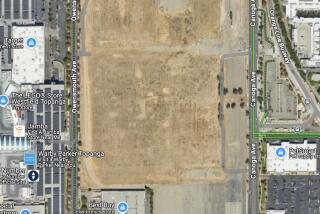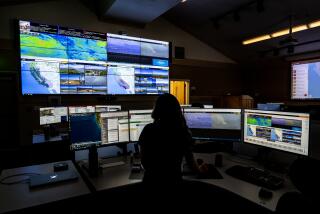Panel Says Field Lab Health Study Threatened
SIMI VALLEY — A shift in federal policy could doom plans for a health study of residents near Rocketdyne’s Santa Susana Field Laboratory, say members of a citizens’ advisory panel.
As a second health study of Rocketdyne workers draws to a close, the panel appointed to oversee it contends funding for a recommended community study is drying up.
Federal Department of Energy funding for the UCLA study of worker chemical exposures--a follow-up to last year’s study of radiation effects--will end Sept. 30, a few weeks after the report is due to be released.
Money to keep the citizens’ oversight panel afloat will dry up at the same time, Energy Department officials and panelists confirmed Thursday. The group was formed in the early 1990s by state legislators to ensure the independence of the worker health studies.
That could scuttle a long-sought health study of residents who live in the communities surrounding the 2,668-acre Santa Susana Field Laboratory near the border of Los Angeles and Ventura counties.
Established in 1947, the open-air field lab was the site of decades of nuclear and rocket engine testing. Now owned by parent company Boeing North American, the lab is home to a $55-million cleanup. The company’s toxic legacy has also spawned a handful of lawsuits from neighbors contending their health or property was damaged by the activities on “The Hill.”
“I’m livid,” said panel member Dr. Caesar Julian, a Simi Valley physician. “I think we haven’t finished the job we set out to do. There has to be follow-up [with residents], and there has to be oversight of that follow-up. . . . If there’s nobody to push for a residents’ study, it’s not going to happen. You don’t think Boeing’s going to pay for it, do you?”
The $1.5 million for the worker health study--a small chunk of which kept the oversight panel going--will end with the close of the federal fiscal year Sept. 30 because the final worker health report will have been released by then, said Roger H. Liddle, who directs the federal Energy Department’s environmental restoration division in Oakland.
And recent policy changes dictate the federal Health and Human Services Department will handle future funding for health studies at Energy Department sites, such as the field lab.
“The study purpose was examining the impact of radiation and chemical exposure on workers at the Santa Susana field lab--that’s been done,” Liddle said. The federal Centers for Disease Control and Prevention now has responsibility to decide on further study, he said.
To advisory panel members, that response is as good as “no more money.” They are petitioning federal and state governments for funding, and state Sen. Cathie Wright and Assemblywoman Sheila James Kuehl are pushing for at least $150,000 to keep the work afloat for another year.
“The advisory panel has been told that the [Energy Department] intends to pull the plug on the panel and any future epidemiological work on Sept. 30,” said anti-nuclear activist Daniel Hirsch, the advisory panel’s co-chairman. “That will succeed in shutting down the panel and future studies.”
The latest developments came to light at a meeting of Rocketdyne officials, regulators and residents late Wednesday.
Also at that meeting, Rocketdyne disclosed it has tested soil for contamination in the Bell Canyon area. This marks the aerospace giant’s first sizable foray into off-site testing, long a concern among neighbors who fault Rocketdyne’s toxic legacy for cancer and other ailments.
The Bell Canyon soil testing, which will check for radiation and chemicals, was voluntary on Rocketdyne’s part.
Rocketdyne’s only other substantial off-site testing has been in uninhabited areas, including Sage Ranch and the Brandeis-Bardin Institute, a center for Jewish studies. Over the years, some individual homes have been checked at the owners’ request, a Rocketdyne official said.
During the testing earlier this month, about two dozen samples were taken from three residential yards, a park, common areas and along the bed of Bell Creek, where rain runoff leaves “The Hill.” For comparison, samples from a buffer area to the south of the field lab was used for background.
“We never would have done this if the homeowners had never asked,” said Steve Lafflam, Rocketdyne’s safety, health and environmental affairs director. “They came to us. They asked us to keep things confidential and not involve all the activists and special interests.”
The results will be released to the homeowners’ group Aug. 17, but Hirsch and other activists are criticizing Rocketdyne for doing the work itself and giving regulators little notice of the testing.
“It stinks to high heaven,” Hirsch said. “It seems to be designed as part of a litigation strategy to declare that there is no off-site contamination so as to reduce the financial expense to the company in pending litigation.”
More to Read
Sign up for Essential California
The most important California stories and recommendations in your inbox every morning.
You may occasionally receive promotional content from the Los Angeles Times.










